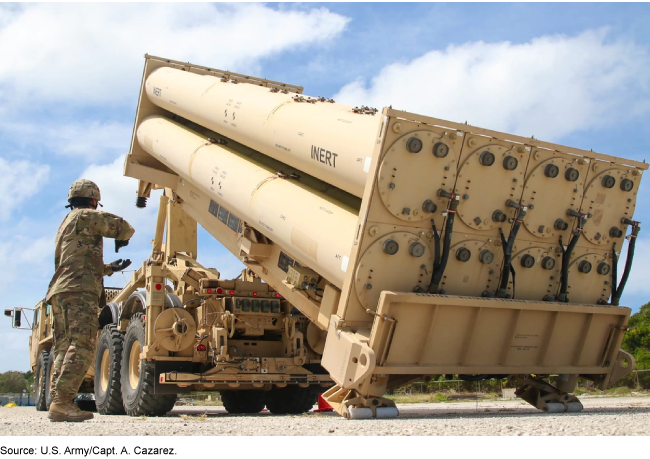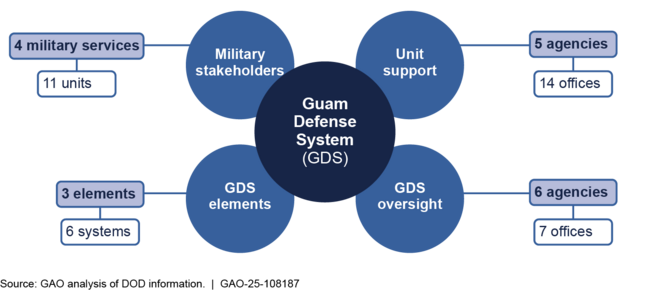Missile Defense: DOD Faces Support Challenges for Defense of Guam
Fast Facts
Guam is home to more than 170,000 Americans and several military installations. Protecting this U.S. territory from missile attack is a Department of Defense priority.
As of March 2025, the defense system in Guam included six missile launchers and one radar.
DOD is planning to deploy additional systems. But it has yet to determine how many personnel are needed to operate the systems, when those personnel would be deployed, and more.
DOD needs this information to, for example, ensure it has enough time to also build military housing and other supporting facilities.
Our recommendations address this and other issues we found.
A missile defense launcher deployed in Guam.

Highlights
What GAO Found
The Department of Defense (DOD) has taken steps to establish an organizational structure for overseeing and sustaining an enhanced missile defense system known as the Guam Defense System (GDS). In addition, DOD has designated lead services for operating and sustaining the elements that make up the GDS. However, there are unresolved challenges that could hamper the success of DOD's efforts:
- DOD lacks a strategy that outlines how and when responsibilities for operating and sustaining GDS elements will transfer to their lead organizations.
- The Army does not have a long-term strategy for integrating with the other military services in Guam to coordinate Army construction and installation support needed to support GDS and personnel.
DOD Offices' Roles and Responsibilities for Missile Defense in Guam

DOD has not fully identified the required number of personnel or completed a deployment schedule for GDS units. This information enables the military services to fund, plan, and build the housing, schools, medical facilities, and commissaries supporting GDS personnel. Absent personnel requirements and a deployment schedule, DOD faces challenges in ensuring adequate support infrastructure at installations in Guam for deployed personnel and their families.
This report is an unclassified release of a previously-issued report DOD classified SECRET//NOFORN. This unclassified release omits one objective and one recommendation due to the use of information classified SECRET//NOFORN, and throughout the remaining objectives omits information DOD has determined to be either SECRET//NOFORN or Controlled Unclassified Information.
Why GAO Did This Study
DOD has determined that protecting Guam is a critically important priority for the Indo-Pacific region. Currently, the department defends Guam with a battery of six missile launchers and one radar. In response to increased military activity by China in the Indo-Pacific region, DOD has begun developing an enhanced missile defense capability to defend Guam.
House Report 118-125 includes a provision for GAO to examine DOD's plans to sustain and support GDS. GAO's review assesses the extent to which DOD has developed (1) an organizational structure for GDS, and (2) plans for supporting GDS units.
GAO conducted site visits to installations in Guam, Hawaii, and Japan to obtain information on plans for Guam missile defense. GAO compared documentation and information obtained from interviews to DOD guidance on organization, personnel support, and coordination.
Recommendations
GAO is making three recommendations, including for the Secretary of Defense to direct relevant military components to develop strategies with a timeline and a plan for transferring responsibilities to lead organizations and for integrating the Army with bases in Guam; and determine personnel requirements and deployment schedules for GDS personnel. GAO made a fourth recommendation, which DOD classified SECRET//NOFORN. DOD concurred with all four of GAO's recommendations.
Recommendations for Executive Action
| Agency Affected | Recommendation | Status |
|---|---|---|
| Department of Defense | The Secretary of Defense should ensure that the Under Secretary of Defense for Acquisition and Sustainment—in coordination with the Director of MDA and secretaries of the military departments—develops a strategy with a timeline and plan for the transfer of responsibilities for operating and sustaining GDS elements to each lead organization. (Recommendation 1) |
DOD concurred with this recommendation. In comments on our report, DOD stated the Under Secretary of Defense for Acquisition and Sustainment will develop a strategy under existing policy for the transition and transfer of operations and sustainment of elements developed by the Missile Defense Agency, and under existing policy for systems developed and operated by the military services. This update is current as of May 2025.
|
| Department of Defense | The Secretary of Defense should ensure that the Secretary of the Army—in coordination with the Commander of JRM, the Secretaries of the Air Force and Navy, and the Commandant of the Marine Corps— develops a long-term strategy for the Army's organization as a supported command at JRM. (Recommendation 2) |
DOD concurred with this recommendation but, as of May 2025, has offered no comment on its intent to implement it.
|
| Department of Defense | The Secretary of Defense should ensure that the secretaries of the military departments determine the personnel requirements needed to operate and sustain GDS, including developing a deployment schedule for those personnel, to allow sufficient time for completing construction of necessary support facilities on Guam. (Recommendation 3) |
DOD concurred with this recommendation but, as of May 2025, has offered no comment on its intent to implement it.
|
